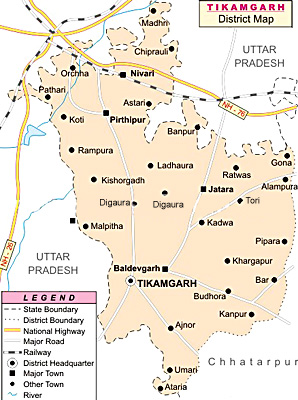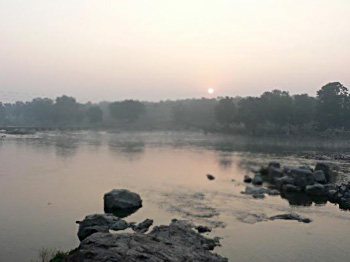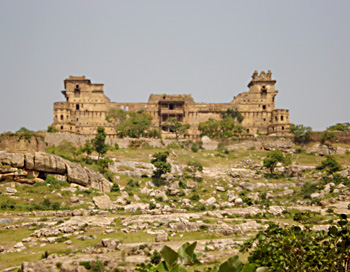 Tikamgarh district is situated in the northern parts of the state of Madhya Pradesh in India. The district has got its name from the headquarters town as Tihri, in Orchha. In the year 1783, Raja Vikramajit shifted his capital from Orchha town to Tihri and renamed it Tikamgarh but it was officially recognised in the year 1887. The name was adopted in the honour of Lord Krishna, Tikam being one of his appellations. The district enjoys a monsoon type climate throughout the year and the average rainfall of the district is forty inches. This district is a famous tourist destination in the state of Madhya Pradesh which attract people from various parts of the state as well as from several other corners of India and also from outside. According to the 2001 census, the total population of the district is 12, 02,998.
Tikamgarh district is situated in the northern parts of the state of Madhya Pradesh in India. The district has got its name from the headquarters town as Tihri, in Orchha. In the year 1783, Raja Vikramajit shifted his capital from Orchha town to Tihri and renamed it Tikamgarh but it was officially recognised in the year 1887. The name was adopted in the honour of Lord Krishna, Tikam being one of his appellations. The district enjoys a monsoon type climate throughout the year and the average rainfall of the district is forty inches. This district is a famous tourist destination in the state of Madhya Pradesh which attract people from various parts of the state as well as from several other corners of India and also from outside. According to the 2001 census, the total population of the district is 12, 02,998.
History of Tikamgarh district
The early history of Tikamgarh district is however not chronicled, though as suggested by the numerous ruins of buildings and other old remains lies scattered at various places, including Orchha, Prithvipur, Garh Kudar, Barana, Digora, Lidhoura, Mohangarg, Baldeogarh and Tikamgarh, it can be said that this district had a glorious past. The Tikamgarh district was a part of the vast empires successively ruled by the Mauryas, the Sungas and the imperial Guptas. It was in the first quarter of ninth century A.D., that Mannuka founded a new dynasty; the Chandella dynasty in this area. Tikamgarh along with Khajuraho and Mahoba formed part of the extensive Chandella Kingdom. The Khangras also held this region especially around Garh Kundar. The rising power of Bundelas in this region resulted in the downfall of the Khangras. The Orchha records trace the descent of the Bundela Kingdom of Orchha from Garh Kudar chiefs of Benaras Hemkaran, also known as Pancham Bundela.
Geography of Tikamgarh district
 Tikamgarh District is situated in the northern portion of Madhya Pradesh. It forms the north-western part of the district of Sagar and lies on the Bundelkhand Plateau between the River Jamni, a tributary of Betwa River and Dhasan River. This district is situated in between twenty four degree twenty six minutes and twenty five degree thirty four minutes to the North latitude and between seventy eight degree twenty six minutes and seventy nine degree twenty one minutes to the East longitude. This district in the Madhya Pradesh state has a triangular shape. The northern margin of this district is very irregular. The maximum length of the Tikamgarh district is about one hundred and nineteen kilometers from North to South and the width is about eighty kilometers. The district of Tikamgarh is bounded by the Chhatarpur district to the East, Lalitpur district> of Uttar Pradesh to the West, Jhansi district to the North and Sagar district to the South. The western and Eastern boundaries are formed by two big rivers.
Tikamgarh District is situated in the northern portion of Madhya Pradesh. It forms the north-western part of the district of Sagar and lies on the Bundelkhand Plateau between the River Jamni, a tributary of Betwa River and Dhasan River. This district is situated in between twenty four degree twenty six minutes and twenty five degree thirty four minutes to the North latitude and between seventy eight degree twenty six minutes and seventy nine degree twenty one minutes to the East longitude. This district in the Madhya Pradesh state has a triangular shape. The northern margin of this district is very irregular. The maximum length of the Tikamgarh district is about one hundred and nineteen kilometers from North to South and the width is about eighty kilometers. The district of Tikamgarh is bounded by the Chhatarpur district to the East, Lalitpur district> of Uttar Pradesh to the West, Jhansi district to the North and Sagar district to the South. The western and Eastern boundaries are formed by two big rivers.
Administration of Tikamgarh district
The district administration of Tikamgarh is under the control of the district collector. The collector is the head of the district and he or she is assisted by his subordinate officers in his general work of administration. The district of Tikamgarh is divided into six tehsils grouped into three sub divisions of Tikamgarh, Niwari and Jatara. The Tikamgarh sub division possesses Tikamgarh and Baldeogarh tehsils, Niwari and Prithvipur tehsil form Niwari Sub Division whereas the Jatara sub division possesses Jatara and Palera Tehsil. There are six development blocks called Tikamgarh, Baldeogarh, Jatara, Palera, Niwari and Prithvipur.
Education in Tikamgarh district
Public instruction in an organised manner came into existence only in the nineteenth century. In the year 1812, a treaty was signed between the British and the then King of Orchha. This was followed by the introduction of Lord Macaulay`s system in the year 1835. However, the first school was founded only in the year 1866, which remained the only educational institution in the state till 1877. In the beginning of the Century the literacy rate was 1.28 percent. In the year 1951 literacy rate has gone up to 3.57 percent. During the Census 1961, the district returned 9.67 percent. In the year 1971, the literacy rate has improved to 14.04 percent. In 1981 the literacy rate moved to 19.16 percent. In the 1991 Census the literacy rate was 34.78 percent. In the 2001 Census the literacy rate was 55.80 percent. There has been substantial progress in the number of educational institutions in the district of Tikamgarh. There are about six Degree Colleges or Post Graduate Colleges in this district imparting instructions in Arts, Science and Commerce. There are also Professional and Technical Schools and Colleges. Various schools are also present in the Tikamgarh district.
In the 1991 Census the literacy rate was 34.78 percent. In the 2001 Census the literacy rate was 55.80 percent. There has been substantial progress in the number of educational institutions in the district of Tikamgarh. There are about six Degree Colleges or Post Graduate Colleges in this district imparting instructions in Arts, Science and Commerce. There are also Professional and Technical Schools and Colleges. Various schools are also present in the Tikamgarh district.
Economy of Tikamgarh district
Agriculture and related pursuits have always been the predominant occupation of the mainly rural area which, though not among the most fertile, has enough to reward well the tradition bound and hard working farming community of the district. Thus, agriculture is the major contributor to the economy of the district of Tikamgarh. The main crops of the district are Jowar, Paddy, Wheat, Urad and Till, Soyabean amongst the oilseeds while sugarcane also is grown to a certain extent. Both the Kharif and Rabi crops are grown in the district. Besides Gram, Urad and Moong are among other important pulses of the district and are grown generally in Kharif. The oilseed crops grown in the district may be mentioned as rape and mustered, groundnut and linseed while Soyabean cultivation gained much popularity.
Tourism in Tikamgarh district
District of Tikamgarh is having several attractions which draw tourists in large numbers throughout the year. One of the attractions in this district is Ahar. This is a village of the Baldeogarh tehsil which lies on the side of Tikamgarh-Chhattarpur road at a distance of twenty five kilometers from the district headquarters. It is an old village said to have been populated by Jamalpur Ahars, which was once an important Jain Centre. Several ruins, old images and temples are located in this village. There are three old Jain temples and one of these temples holds an image of Shantinath, having a height of twenty feet. A tank belonging to the Chadella days with a fine dam stands here. Other places of tourist interest include the Achroo Mata, Baldeogarh, Jatara, Kudar, Kundeshwar, Madkhera, Niwari, Orchha, Palera, Papora, Prithvipur, Tikamgarh town, etc.






